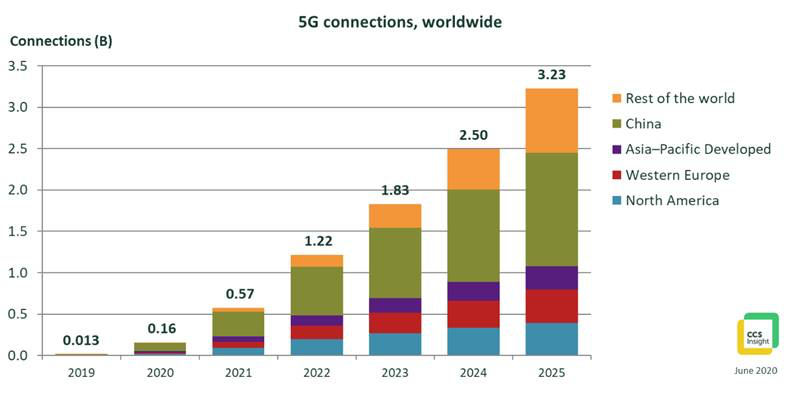The long-term outlook for 5G adoption remains bright and the market will experience little lasting damage from the coronavirus pandemic, according to a new forecast by technology research firm CCS Insight.
Although the projections for 2020 and 2021 are lower than before the pandemic struck, an increase in the long-range forecast now means that global 5G connections are expected to pass 1 billion in 2022, before surging to 3.2 billion by the end of 2025. This will be equivalent to nearly one mobile connection in every four throughout the world in 2025.
The current health crisis will have only a moderate and short-term effect on adoption, caused by relatively minor delays in the roll-out of 5G networks and sale of spectrum as well as macroeconomic uncertainty after governments lift lockdowns. These trends will be partially offset by widespread availability of 5G smartphones and accelerating momentum for 5G in China. An important assumption in CCS Insight's forecast is that the global mobile phone market will make a full recovery by 2022, with shipment numbers exceeding those in 2019.
"The arrival of new chipsets and fierce competition in the shrinking global mobile phone market will lead to a quick introduction of 5G in more moderately priced smartphones in 2020", remarked Marina Koytcheva, CCS Insight's vice president of forecasting. "We're going to see prices of supporting devices tumble below $400 faster than previously expected, a trend that will be instrumental in 5G becoming more accessible to a much wider demographic".
Despite disruption in the first quarter of 2020, CCS Insight has increased its forecast for 5G connections in China in 2020 from previous projections. The firm now expect nearly 100 million 5G connections at the end of the year, soaring to more than 1 billion in 2024.
Kester Mann, director of CCS Insight's consumer and connectivity research, explained, "Strong desire from local operators to make up for delays caused by Covid-19 in the first quarter, combined with enthusiastic support from the government, wide availability of more-affordable 5G handsets and the unrelenting ambition of local network equipment and handset manufacturer Huawei, will spur demand".
Already, about four in every 10 handsets bought in China are 5G-enabled, with total 5G device sales on track to exceed 100 million in 2020, according to CCS Insight. Network deployment continues to pick up the pace too, as China pushes to deploy a massive 1 million 5G base stations before the end of 2020.
Elsewhere, 5G momentum has continued in many countries despite inevitable delays and restrictions from the pandemic. Adoption in South Korea remains strong, with more than 6 million 5G connections about a year after the networks went live. Japan's three main operators have now all launched 5G, albeit later than first expected. And in Europe, 5G networks are now up and running in 17 countries, including Belgium, the Netherlands, Norway, Poland and Sweden, which all saw their first commercial launches during the lockdowns.
Beyond the short-term disruption in the first half of 2020, which will have some ripple effect in the rest of the year and in 2021, it's clearer than ever that mobile networks are a critical part of national infrastructure. Investment in 5G will continue at speed in the next years, as telecom operators look to boost the capacity and efficiency of their networks. This is a leading source of optimism for 5G, in stark contrast with the current gloomy outlook threatening many other industries.
An area where disruption to the world economy will slow adoption of 5G more noticeably is the industrial Internet of things (IoT), including smart cities. Industrial companies and city authorities are shifting their short-term priorities, which will lead to some delays in adoption of 5G connectivity, with China again a notable exception. Still, CCS Insight's forecast shows that by 2025, 270 million IoT devices will be connected to 5G networks worldwide.
Despite these positive expectations for 5G, global uncertainty caused by the pandemic means the forecast also carries significant risk. Potential downsides include slower-than-expected recovery of the mobile phone market; a longer or more severe global recession that halts purchases by consumers and businesses and telecom operators' ability to deploy networks at pace; escalation of the geopolitical tension that has ramped up during the crisis; and wider spread of misinformation and conspiracy theories that have led to mindless acts of violence against 5G infrastructure.




